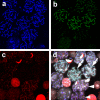Roles of cohesin and condensin in chromosome dynamics during mammalian meiosis
- PMID: 24162807
- PMCID: PMC3934126
- DOI: 10.1262/jrd.2013-068
Roles of cohesin and condensin in chromosome dynamics during mammalian meiosis
Abstract
Meiosis is a key step for sexual reproduction in which chromosome number is halved by two successive meiotic divisions after a single round of DNA replication. In the first meiotic division (meiosis I), homologous chromosomes pair, synapse, and recombine with their partners in prophase I. As a result, homologous chromosomes are physically connected until metaphase I and then segregated from each other at the onset of anaphase I. In the subsequent second meiotic division (meiosis II), sister chromatids are segregated. Chromosomal abnormality arising during meiosis is one of the major causes of birth defects and congenital disorders in mammals including human and domestic animals. Hence understanding of the mechanism underlying these unique chromosome behavior in meiosis is of great importance. This review focuses on the roles of cohesin and condensin, and their regulation in chromosome dynamics during mammalian meiosis.
Figures


Similar articles
-
The Regulation and Function of Cohesin and Condensin in Mammalian Oocytes and Spermatocytes.Results Probl Cell Differ. 2017;63:355-372. doi: 10.1007/978-3-319-60855-6_15. Results Probl Cell Differ. 2017. PMID: 28779325 Review.
-
Condensins I and II are essential for construction of bivalent chromosomes in mouse oocytes.Mol Biol Cell. 2011 Sep;22(18):3465-77. doi: 10.1091/mbc.E11-05-0423. Epub 2011 Jul 27. Mol Biol Cell. 2011. PMID: 21795393 Free PMC article.
-
SMC5/6 is required for the formation of segregation-competent bivalent chromosomes during meiosis I in mouse oocytes.Development. 2017 May 1;144(9):1648-1660. doi: 10.1242/dev.145607. Epub 2017 Mar 16. Development. 2017. PMID: 28302748 Free PMC article.
-
Condensin I protects meiotic cohesin from WAPL-1 mediated removal.PLoS Genet. 2018 May 16;14(5):e1007382. doi: 10.1371/journal.pgen.1007382. eCollection 2018 May. PLoS Genet. 2018. PMID: 29768402 Free PMC article.
-
Meiotic chromosome structure and function in plants.Cytogenet Genome Res. 2014;143(1-3):6-17. doi: 10.1159/000365260. Epub 2014 Jul 30. Cytogenet Genome Res. 2014. PMID: 25096046 Review.
Cited by
-
Meiotic Chromosome Dynamics in Zebrafish.Front Cell Dev Biol. 2021 Oct 8;9:757445. doi: 10.3389/fcell.2021.757445. eCollection 2021. Front Cell Dev Biol. 2021. PMID: 34692709 Free PMC article. Review.
-
Cloning, Molecular Characterization and Expression Patterns of DMRTC2 Implicated in Germ Cell Development of Male Tibetan Sheep.Int J Mol Sci. 2020 Apr 1;21(7):2448. doi: 10.3390/ijms21072448. Int J Mol Sci. 2020. PMID: 32244802 Free PMC article.
-
The Accidental Ally: Nucleosome Barriers Can Accelerate Cohesin-Mediated Loop Formation in Chromatin.Biophys J. 2020 Dec 1;119(11):2316-2325. doi: 10.1016/j.bpj.2020.10.014. Epub 2020 Nov 10. Biophys J. 2020. PMID: 33181117 Free PMC article.
-
Distinct Roles of Meiosis-Specific Cohesin Complexes in Mammalian Spermatogenesis.PLoS Genet. 2016 Oct 28;12(10):e1006389. doi: 10.1371/journal.pgen.1006389. eCollection 2016 Oct. PLoS Genet. 2016. PMID: 27792785 Free PMC article.
-
Meiotic sex chromosome cohesion and autosomal synapsis are supported by Esco2.Life Sci Alliance. 2020 Feb 12;3(3):e201900564. doi: 10.26508/lsa.201900564. Print 2020 Mar. Life Sci Alliance. 2020. PMID: 32051254 Free PMC article.
References
-
- Peters JM, Tedeschi A, Schmitz J. The cohesin complex and its roles in chromosome biology. Genes Dev 2008; 22: 3089–3114 - PubMed
-
- Prieto I, Suja JA, Pezzi N, Kremer L, Martinez AC, Rufas JS, Barbero JL. Mammalian STAG3 is a cohesin specific to sister chromatid arms in meiosis I. Nat Cell Biol 2001; 3: 761–766 - PubMed
-
- Lee J, Iwai T, Yokota T, Yamashita M. Temporally and spatially selective loss of Rec8 protein from meiotic chromosomes during mammalian meiosis. J Cell Sci 2003; 116: 2781–2790 - PubMed
Publication types
MeSH terms
Substances
LinkOut - more resources
Full Text Sources
Other Literature Sources
Research Materials

